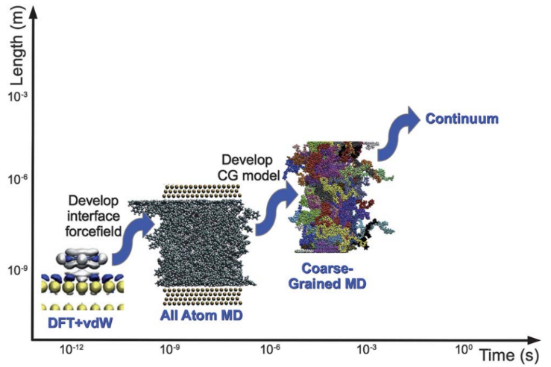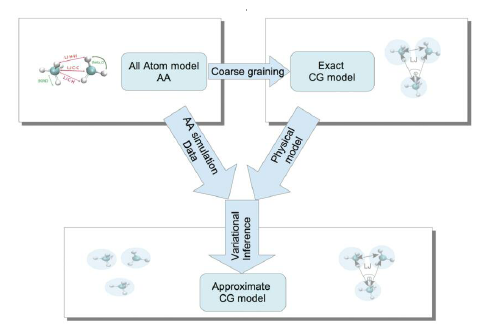This topic considers nanostructured (complex fluids and macromolecular) materials, such as films and nanocomposites. Macromolecular systems (polymers) are characterized by the presence first, of chemical bonds linking the atoms into chains and second, of intermolecular forces between the macromolecular chains. This feature (energy), together with the flexibility of the chains due to internal rotation of the units (entropy), and the interaction between different components-phases (interfaces) determines the properties of such hybrid systems.
Various technological issues are related to the coupling of interfaces with the macroscopic properties (mechanical, structural, dynamical, rheological, etc.) of such materials. For example, polymer and/or biopolymer/solid interfaces play a key role in applications involving polymer/particle nanocomposites, since the strength of chain attachment at interfaces (a quantitative thermodynamic measure of which is the work of adhesion) governs the mechanical properties of the structure. In addition, the organic/inorganic nature of their properties indicates their potential application as structural materials in renewable energy, drug design, aerospace, automotive, electronics and packaging industries.
The main challenge in the computational study of the above systems is to predict their macroscopic properties directly from their molecular structure (structure-property relations). This will allow the design of novel materials with the desired properties. To achieve this, multi-scale simulation methodologies that combine different levels of description are necessary, due to the enormous range of length and time scales characterizing such systems.
Using our expertise, we will apply such a hierarchical multi-scale methodology that combines different simulation techniques in a systematic way: From (a) ab-initio and DFT calculations of small systems, and (b) all-atom molecular dynamics, and Monte Carlo, simulations of large systems (of the order of 106 atoms), up to (c) rigorous mesoscopic coarse-grained (CG) models, and (d) continuum modelling and simulations, e.g. finite elements, that can be used to describe phenomena in the engineering scale (see Figure 2a). In all cases, results from the simulations at a more detailed scale are used to parametrize models at the less detailed (coarser) one.
The above hierarchical methodology, and the associated large-scale simulations involving millions of atoms/particles, will be used to predict structure-property relations of several systems with important technological applications, such as:
- Graphene-based polymer nanostructured systems,
- Polymer nanocomposites,
- Thin films,
- Systems under non-equilibrium conditions.
Important properties of the above systems will be predicted, including among others:
- Thermodynamics (pVT data, etc) and structure of the (fluid/solid, fluid/fluid or solid/solid) interface
- Mechanics (Young modulus, relaxation modulus)
- Dynamics and rheology of complex fluids (e.g. relaxation times, diffusion coefficient, viscosity, friction coefficient)
- Wetting properties


